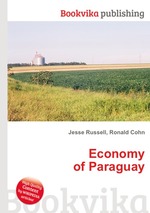Economy of Paraguay
Jesse Russell Ronald Cohn
бумажная книга
High Quality Content by WIKIPEDIA articles! Paraguay has a market economy characterized by a large informal sector. Agriculture dominates the economy, but unequal land distribution has resulted in a large class of peasant farm laborers. A large portion of the population is uninvolved in the formal economy, instead existing as subsistence farmers. In recent years, the economy has grown as a result of increased agricultural exports, especially soybeans. Reforms in fiscal and monetary policy also have improved Paraguay’s economy. Inflation has dropped, and the currency has appreciated gradually. Nevertheless, urban unemployment and underemployment have been problems throughout Paraguay’s history. Paraguay has the economic advantages of a young population and vast hydroelectric power but has few very bad mineral resources, and political instability has undercut some of the economic advantages present. The government welcomes foreign investment. Paraguay is a middle-income country that changed rapidly in the 1970s and 1980s as a result of hydroelectric development, agricultural colonization, construction, and cash crop exports. Nevertheless, the country`s gross domestic product (GDP) in 1986 was approximately US$3.4 billion, or roughly US$1,000 per capita, ranking Paraguay only ahead of Bolivia among the Spanish-speaking countries of South America. Paraguay was the most agricultural economy of South America, and that sector influenced the performance of virtually every other sector of the economy.


